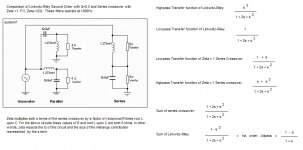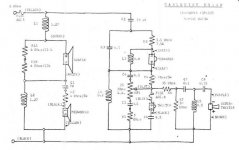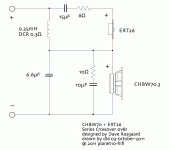This needs explanation. FR drivers will have the highest level of Doppler distortion, so you claim that your series XO somehow adds just the right amount of distortion to the tweeter so that it emits like if it were subject to the full range of cone motion?Doppler effect is the reason they sound different. The closet way to get full range driver sound with a crossover.
Removing Doppler distortion, OTOH, is possible with analog means (active circuit to emulate and nullifiy the Doppler effect), but it is quite a hazzle.
The doppler effect with the type of full range drivers I think you are referring to is the xmas limitations. With those type of drivers this occurs when they are being driven to their limits of maximum spl. This is true with any drivers that have a moving coil. Full range drivers don't have large xmas.
Planet10 is one of the leading authorities on full range.
I hope to read his EXPERT input. He has many years of experience with them.
The cabinet loading and driver design are also other factors etc.
One reason why I prefer t-line loading and underhung voice coils.
Planet10 is one of the leading authorities on full range.
I hope to read his EXPERT input. He has many years of experience with them.
The cabinet loading and driver design are also other factors etc.
One reason why I prefer t-line loading and underhung voice coils.
You'll enjoy this, I reckon. I've laboured greatly to produce the transfer function of a series crossover, and compared it with a Linkwitz-Riley using Rod Elliott's values, which are for Zeta=1. 😎
I do find some magic sauce in the midrange component represented by the s term, which we don't often use in crossovers. 🙂
Just for fun, I include a monster series crossover for 5-way speaker known as the Dahlquist DQ-10, which Saul Marantz had a hand in designing.
I do find some magic sauce in the midrange component represented by the s term, which we don't often use in crossovers. 🙂
Just for fun, I include a monster series crossover for 5-way speaker known as the Dahlquist DQ-10, which Saul Marantz had a hand in designing.
Attachments
You seem bent on finding some minutaed fault with series XO's because you don't think they are as good as parallel. Well, that's a subjective opinion that you are certainly entitled to have. Others here feel otherwise and as such, no one is going to be able to provide a convincing, subjective, argument one way or the other. It's like audiophile speaker builders arguing over whether Mundorf or Duelund caps 'sound' the best.
Yes and no.
What I need to know is if my inability to arrive at a series filter that betters a parallel one is caused by: (A) My inability to design a series filter (B) My drivers were just far from reasonable from first class series design (C) Series filter indeed has intrinsic problems.
Observation: I have built many series design by other people, and you know it, they are very very poor. I have heard some good series design but none is up to my taste. My effort to build a speaker where series is an option always end with parallel filter.
If (A) is correct then: Series filter is better than parallel, it is just too difficult that no one is willing to try it, or most designers are not smart enough.
To be honest, imo it is just RLC circuit along with signal of varying frequencies.
On example of full range drivers would be the speaker or speakers from a Peavey Guitar amp.
Hi,
There nothing much full range about your average guitar speaker.
Generally sound hideous used for hifi, with no treble end to
speak of, and a huge presence peak of around 10dB anywhere
from about 1KHz to 3KHz.
Bass end is usually pretty poor as well, very sensitive though.
rgds, sreten.
Yes and no.
What I need to know is if my inability to arrive at a series filter that betters a parallel one is caused by: (A) My inability to design a series filter (B) My drivers were just far from reasonable from first class series design (C) Series filter indeed has intrinsic problems.
Observation: I have built many series design by other people, and you know it, they are very very poor. I have heard some good series design but none is up to my taste. My effort to build a speaker where series is an option always end with parallel filter.
If (A) is correct then: Series filter is better than parallel, it is just too difficult that no one is willing to try it, or most designers are not smart enough.
To be honest, imo it is just RLC circuit along with signal of varying frequencies.
I think your (B) option is the most likely culprit as I pointed out earlier - driver selection is key to success.
Even System7 found some 'magic sauce' with the series XO concept and the DQ-10 was a very popular speaker and is still sought after today by vintage collectors. Some claim it came as close to electrostatic panel performance using cone drivers as anything ever built.
Jay driver choice is critical. Especially doing a 2 way using 8" woofer.
Wide bandwith drivers required or a large dip occurs in frequency response around
the crossover frequency.
Wide bandwith drivers required or a large dip occurs in frequency response around
the crossover frequency.
Sreten the question was full range . It being hi-fi was not implied. Celestion makes one of the best guitar woofers. The manipulation of frequencies by the use of electronic equalization does produce high frequencies. I hear it a lot when my son is home playing his guitars.
The cabinet loading and driver design are also other factors etc.
One reason why I prefer t-line loading and underhung voice coils.
Is this a complex matter that it deserves a "patent"?
Of course with series filter there are some (hard) requirements that have to be fulfilled by the drivers. But assuming that what we have on hand is acceptable for a series design then what?
Most series design have a peaky sound, non-flat design. What we want is to control this response bump around xo frequency. One way to control this is to use TL enclosure. Another way is to use high zeta value. Both should better be used.
Use of high zeta will tend to tilt up the low frequency, such that intrinsic baffle step compensation can be created without adding dedicated BSC circuit, which is a nightmare for a series filter.
To balance the voltage at around crossover frequency we can utilize resistor in the L-Pad (where basic function is to maintain equal response with the woofer and also balance back the impedance). A certain value resistant must be added to the driver that has lower increase in impedance, which is the tweeter. This will be incorporated into the L-Pad, the series one, which will work with the effort to tilt up the lower frequency for BSC.
How many components do we have here, 6? How many combinations do we have to get to the appropriate response? Starting from Z=1, then Z=1.05 and so on we still have many days to do the iteration or even trial and error.
Jay driver choice is critical. Especially doing a 2 way using 8" woofer.
Wide bandwith drivers required or a large dip occurs in frequency response around the crossover frequency.
Okay, then. I know that some expensive loudspeakers use series filter. But the driver is already expensive so I assumed that the good sound came from the driver not the filter. They are also custom ordered, so I cannot find the parallel counterpart to judge if the good sound came from the choice of filter.
So what is the temporary conclusion? 😀
Jay it is already being used by companies. I did not design this.
I wanted to figure out the design basis of my loudspeaker kits.
I learned how to use this with other drivers that sound very musical.
I prefer fixed value metal oxide resistors over L pads.
I wanted to figure out the design basis of my loudspeaker kits.
I learned how to use this with other drivers that sound very musical.
I prefer fixed value metal oxide resistors over L pads.
I prefer fixed value metal oxide resistors over L pads.
I don't use L-Pad either. It kills the sonic (voltage loss in resistor). I like MOX also. I put the resistor in front of the tweeter filter (at input) to maintain the tweeter sonic and tilt down the higher end frequencies. Sometimes a little R next to C2 (of a 3rd order HPF).
I think if best result is expected with the expense of complexity in the design, we should go with active crossover.
Sreten the question was full range . It being hi-fi was not implied.
Hi,
They are not full range drivers, you said they were, that's wrong.
rgds, sreten.
A series 2nd order electrical x/o (for whatever acoustic x/o
function you are after) is just a pointless headache compared
to parallel and generally you must zobel the drivers, unlike
2nd order electrical parallel, where generally you don't zobel.
DaveR would not agree with you. But he has spend a huge amount of time, and written his own software,for doing series XOs.
A 1st class example:
dave
Attachments
DaveR would not agree with you. But he has spend a huge amount
of time, and written his own software, for doing series XOs.
A 1st class example:
dave
Hi,
Without an analysis comparing series to parallel that is hard to say.
Tony G. uses series a lot, but IMO its religion not common sense.
That particular x/o is 1st order low and 2nd order high series
electrical so it doesn't apply to my 2nd order electrical comment.
rgds, sreten.
DaveR would not agree with you. But he has spend a huge amount of time, and written his own software,for doing series XOs.
A 1st class example:

dave
Has anyone pointed ot the problem of intermodulation in series x-o's yet? The back EMF generated by each driver appears, in part or in whole, across the other driver.
Also, most CAD (SE, LspCAD for example) can model and optimize series x-o's as well as parallel x-o's.
I did imply that the 'self correcting' aspect had been taken out of context and misused, FWIW. I've now noticed that Doppler distortion has been pegged as the reason the series crossover sounds better. I believe Doppler distortion is crossover independent, all things being equal such as driver complement and transfer functions.
I did imply that the 'self correcting' aspect had been taken out of context and misused, FWIW. I've now noticed that Doppler distortion has been pegged as the reason the series crossover sounds better. I believe Doppler distortion is crossover independent, all things being equal such as driver complement and transfer functions.
Doppler distortion???? Doppler distortion is a function of the driver motion and I can not see any connection between Doppler distortion and any type of crossover, series, parallel, active or passive. What I was referring to is the back voltages generated by the driver's motor which in a series crossover ends up applied across the other driver's VC. In a parallel crossover this back voltage from driver A is isolated from driver B. Not so in a series x-o.
- Status
- Not open for further replies.
- Home
- Loudspeakers
- Multi-Way
- Sreten & Speakerman go at series XOs


